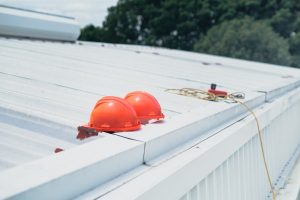15 Safety Tips When Tackling DIY Roofing Projects

DIY can be a cheap and quick way to get a project done yourself, but it also comes with many risks that some people completely overlook.
What is DIY Roofing?
DIY Roofing, short for “Do-It-Yourself Roofing,” refers to the practice of homeowners or individuals undertaking roofing projects on their own, without hiring professional contractors or roofers. It involves repairing, replacing, or maintaining various components of a roof, such as shingles, underlayment, flashing, gutters, and vents, without external assistance. DIY roofing projects are often pursued to save costs and gain a sense of accomplishment by completing the work independently.
Preparing for the DIY Roofing Project
Assessing the Roofing Project Scope:
- Determine the specific roofing task you plan to undertake (e.g., shingle replacement, patching leaks, installing vents).
- Evaluate the complexity and scale of the project to ensure it aligns with your DIY skills and experience.
- Consider the time and effort required to complete the project, and set realistic expectations.
Acquiring Necessary Permits and Insurance:
- Check local building codes and regulations to determine if a permit is required for your roofing project.
- Obtain all necessary permits and approvals from local authorities before starting any work.
- Review your homeowner’s insurance policy to understand coverage for DIY projects and consider additional coverage if needed.
Gathering Tools and Materials:
- Create a list of all the tools and materials required for the roofing project.
- Ensure you have the necessary safety equipment, such as harnesses, hard hats, and goggles.
- Purchase high-quality roofing materials and tools from reputable suppliers.
Checking Weather Conditions:
- Avoid starting the project during adverse weather conditions, such as rain, snow, or strong winds.
- Check weather forecasts for the duration of the project to plan for suitable working days.
- Extreme temperatures can also impact roofing materials, so consider weather-related factors in your planning.
Assessing Personal Skills and Limitations:
- Be honest about your DIY abilities and knowledge related to roofing projects.
- If you lack experience or expertise, consider seeking guidance from experienced DIYers or hiring a professional for certain aspects of the job.
- Never attempt a roofing project that exceeds your physical abilities or puts your safety at risk.
Establishing a Budget:
- Make a realistic budget for the roofing project, accounting for materials, tools, permits, and any unforeseen expenses.
- Compare prices from different suppliers to get the best value for your money.
Planning the Project Timeline:
- Develop a comprehensive project timeline, breaking down tasks into manageable steps.
- Allocate sufficient time for each phase of the project, including any learning curves or unexpected delays.
- Avoid rushing the project to ensure a careful and accurate installation.
Informing Family Members and Neighbors:
- Communicate your roofing project plans with family members and neighbors to keep them informed.
- Advise nearby residents about potential noise and disruptions during the construction period.
- Consider safety precautions to protect people and property around the work area.
Tips for DIY Roof Repair
While a project might not be particularly dangerous for an experienced contractor, for an amateur it could be a completely different story, and therefore you must be very cautious when tackling a DIY roofing job.
Choose Safe Footwear
The footwear that you wear is critical. An old pair of running shoes isn’t good enough; you need a soft soled work boot that will protect you from any falling material and provide you with extra grip on the roof.
Work in Good Weather
The weather in which you work can make a huge difference to the safety of the job. Wet and windy conditions will increase the chances of you falling drastically, while bright sun can make it more difficult to see. Ideally, you should work on a warm and calm day in the morning or late afternoon to reduce the chance of any accidents from happening.
Work Slowly and Carefully
Roofing can be incredibly tedious, and when you’re not getting paid to do it, it is even more boring. However, rushing at a job is going to increase the chance of you making a mistake which could cause a serious injury or death. Take your time and work carefully, it will leave you with a superior roof and a healthy body!
Clean Your Work Area
Before you start working it’s important that you take the time to completely clear your work area, both on the roof and on the ground surrounding the ladder and your materials. A safety warning from Zimmerman roofing company Northface Construction, “Failure to clean the area will lead to you tripping and falling over objects which can cause severe injuries when you’re carrying work equipment or materials.”
Consider Toe Holds
Toe holds are sections of wood that you nail into the roof temporarily to give you a section to rest your feet. These holds can give you extra stability and traction on the roof, which is particularly important for amateur roofers.
Wear a Safety Harness
Very few DIY roofers take this step, and many have been permanently injured as a result. A harness doesn’t need to be expensive and can be rented from many companies. They will attach to an object and prevent you from falling from the roof or ladder.
Notify a Family Member or Neighbor
Before you start working it’s wise to inform a family member in the home or your neighbor. If they hear anything they will be more likely to come outside to help, which can be the difference between life and death.
Keep Children and Pets Away
It’s not only your safety that you must be concerned about, but you should also think about any children or pets that could wander around under your working area. Keeping them away either with a physical barrier or by locking them inside can reduce the chance of them becoming injured.
Keep Metal Ladders Away from Power Lines
If you’re using a strong metal ladder, be careful to ensure that it’s kept a good distance away from any overhead power lines that could be connecting to your or your neighbor’s homes.
Maintain Three Points of Contact with the Ladder
When you’re climbing a ladder, you should ensure that you always have three points of contact with the ladder. Climbing too fast will prevent this, and therefore you must take your time, especially if you’re carrying something up with you.
Setup Your Ladder Properly
To set up your ladder, you should take the time to do it properly. Failure to do this can lead to the ladder slipping from its rest or tipping sideways and causing you to fall.
Don’t Shoot Nails
When using a nail gun, you should never be shooting nails; you should only pull the trigger when it is fully in contact with the surface and therefore goes straight into the roof rather than flying through the air.
Keep the Nail Gun Safety On
Before pulling the trigger and punching a nail out, you should ensure that the safety is always on when not in use, this is particularly important when you’re climbing the ladder.
Don’t Carry too Much at Once
Rushing at the job is only going to cause mistakes and mistakes lead to injuries. Rather than attempting to carry everything up in one go, carry less than you think you can handle.
Lift with Your Legs
Finally, when you’re picking up an object, even if it is relatively light, keep your spine straight and lift with your legs to prevent any back or hip injuries.
Conclusion:
DIY roofing project can be a rewarding and cost-effective endeavor, but it should never be taken lightly. The importance of safety cannot be overstated when working on a roof, as it involves significant risks that could lead to severe injuries or even fatalities.
By following essential safety tips and guidelines, you can ensure a successful and incident-free roofing project.






